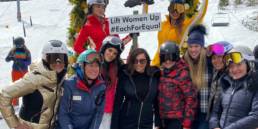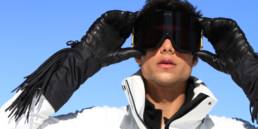DARTMOUTH’S IVY LEAGUE FOR SKIERS
DARTMOUTH COLLEGE’S CAREFUL CULTIVATION OF WRITING, RHETORIC, AND THE STEM CHRISTIANA
STORY BY DAVID SHRIBMAN
There are two stories of how Dartmouth College— conceived in wilderness in the 18th century and consecrated with woodsmoke in the 21st, the northernmost of the Ivy League institutions, and the only one with its own ski area—found the mountain outpost where it would train its Olympic champions and teach its bookish students the nuances of the stem Christiana turn in the 1950s.
Established version: A group of senior college officers, determined that Dartmouth preserve its position as the preeminent skiing college in the United States, set out in a Jeep to examine possible sites for a new ski area, become snowbound up to the axles in the New Hampshire outback, and in their peril see before them the pleasing prospect now known as Holt’s Ledge, the site of the Dartmouth Skiway.
Alternate version: That very same group of college grandees, on the very same mission in the very same Jeep, set out on a mission to find the best possible setting for a ski area for the only Ivy League college with a trustee subcommittee on skiing. One of them, John Meck, suddenly is possessed of a wicked need to take a leak. As he completes his task his eyes alight on Holt’s Ledge.
Which of those versions do you suppose we Dartmouth alums cherish above all other stories?
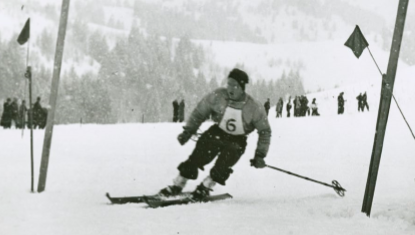
That story—the college vice president and the pee—may sound like a Hans Christian Anderson fairy tale but we believe it devoutly. Here are some other things that we graduates of Dartmouth—the only Ivy college whose hymns could conceivably include the phrase, “crunch of feet on snow” or whose songs celebrate “the snow drifts deep along the road”—consider part of our creed, most of which may actually be true:
The Slalom ski race was invented by a Dartmouth physics professor, eight pine branches stuck on a snowy hill that changed winter sports forever. The Downhill was invented by one of ours, too. Also, the Giant Slalom. Bunny Bertram, a Dartmouth graduate, rigged the first ski tow in the United States. The first overhead cable ski lift was at Dartmouth. More than 120 members of the 10th Mountain Division, known as the Army’s ski troops, were Dartmouth men. Some 132 Dartmouth men and women have competed in the Winter Olympics.
There is more: Dartmouth skiers and ski coaches wrote four books on skiing in the period 1937-1939 alone. John Caldwell, a Dartmouth graduate and Nordic combined skier at the 1952 Olympics, wrote the most widely sold ski book in history. And, a half century ago, the college abandoned its requirement that high school students include a photograph with their application because the standard head-and-shoulder portrait did not show whether the young person was wearing skis.
Only kidding about the application pictures. But for more than a century, Dartmouth has been the skiing college—the skiers’ college, the college where a Religion major could take skiing for credit and then go off to do graduate work at Cambridge University in philosophy of religion and ponder the difficult writings of Ludwig Wittgenstein. It has stood apart from its Ivy sisters in its joyous celebration of the outdoors and its careful cultivation of skiers. Can it be a coincidence, or is it just poetry, that one of its students was a bard whose last name was Frost?
Dartmouth, alone among American colleges, has sent athletes to every Winter Olympics ever held, with a glittering delegation (one gold, one silver, one bronze) at Sochi—a medal haul equal to that of Australia and one behind Great Britain. Hannah Kearney, who won the gold medal in freestyle moguls skiing at Vancouver in 2010, took the bronze at Sochi, while Andrew Weibrecht, who won the bronze medal in the Super-G four years earlier, took silver at Sochi, finishing just ahead of Bode Miller. Four of the six American ski racers at the Cortina Olympics in 1956 were from Dartmouth. A fifth, Chiharu Igaya, won the silver medal for Japan (beaten only by Austria’s Toni Sailer) and was a member of the International Olympic Committee for 30 years.
Dartmouth has also bred a ski area designer, Sel Hannah, whose fingerprints are on hundreds of ski area blueprints through his company Sno-Engineering, Inc., and a ski fashion designer—Diane Boyer owns Skea, a luxury mountain lifestyle brand. Other graduates have helped create countless ski resorts, including Sun Valley in Idaho and Waterville Valley in New Hampshire. Alumni have operated scores of ski hostelries, including the Trapp Family Lodge in Stowe, Vermont—Sam Von Trapp is a Dartmouth grad—where the sound of skiers gathering for après-ski tales in an Austrian-style setting has produced a special sound of music for more than six decades.
Indeed, for years the phrase “Dartmouth Hospitality” was a prominent and poignant advertising phrase that promised a signature winter experience—roaring fire in the living room, piles of jigsaw puzzles on the coffee table, a splendid dinner and a hot breakfast for (in the early days) as little as $3.50 a night. One actual hostelry run by a Dartmouth grad promised hard beds, cold steam, and lard cooking, adding: “But A Skiers’ Welcome Awaits You.” The Dartmouth graduate who today operates the cozy Mont Habitant ski area in Saint-Sauveur-des-Monts, Quebec has a framed map of Dartmouth’s outdoor venues on his wall.
The special mixture of geography, geology and chemistry found in northern New Hampshire enabled a college planted in the wilderness to develop an outdoors ethos and a hearty outlook on life. Dartmouth attracted an unusual breed of student, the sort who knew all the constellations (not only the Big Dipper and the belt of Orion) and who, in the days when ski waxes were an essential element of the downhill sport, knew when to use the red one (warm weather) and when to use the green one (cold conditions).
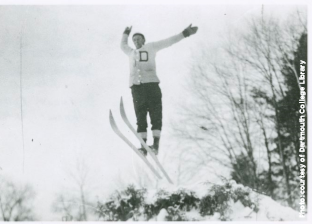
We have our own doctrine, refined in the pine groves and birches and also on the quad chair on Winslow Mountain, which faces Holt’s Ledge at the Dartmouth Skiway. This
we believe: That hiking boots qualify as business casual attire; every closet should include at least one red and black check shirt (we wash ours at least once every five years whether they need it or not); the smell of wet wool is an aphrodisiac; and that frozen granular on Worden’s Schuss, up at the Skiway, is heaven—even if others define it as “boilerplate ice.”
We know the difference between a bear paw snowshoe and a beavertail snowshoe. (Many of us own a pair of each, preferably hand-shaped white ash with a webbing of dressed caribou hide, and don’t even mention the modern versions made with aluminum tubing and Neoprene decks.) We know how to sharpen an ax with a dual-grip handstone. We know the attributes of three different systems of snowmaking, and prefer those produced by HKD Snowmakers, the three letters standing for Herman Kress Dupre, who sent four skiing daughters (and four grandchildren, one of whom was a member of the US Nordic combined team) to Dartmouth.
At least that is what we tell our friends, poor things, who had to settle for a degree from Harvard, where, it can be said with confidence, no senior associate dean ever had the head of a moose, shot in New Brunswick almost a century ago, mounted over his chair in his office. Ours did, and it took two beefy men from Buildings and Grounds to get it on the wall.
“We think of ourselves as the kind of people who know how to do our own ski tune-ups, who can go winter camping and stay warm, who can build a campfire in the dark in the rain, who know which end of the canoe is the front, can use a map and compass and think GPS units are an insult,” says Daniel M. Nelson, who after a star turn as the moose-head dean became Dartmouth’s Director of Outdoor Programs, the only such title in the Ivy League.
I caught up with him last February after a wilderness weekend in which he led a bunch of students on a ski and dogsled expedition in a beloved tucked-away, frosty corner of New Hampshire called the Dartmouth Grant. Dan and I became fast friends when we were both students. I lived respectably in a toasty dorm (though the windows were propped open in every room from December through March) but he lived with a goat in a riverside cabin with neither running water nor electricity. The cabin was 13 miles from campus. He didn’t own a car.
He is the Classic Dartmouth Guy, and I swear on a pile of trail maps that I didn’t make up a word of his story. Nor did I make this up: A Dartmouth sociology major met his thesis advisor when he tried to pick up his pretty wife on the ski slopes in 1939. The budding sociology scholar was my uncle, Class of 1941.
Of course a bit of this Dartmouth stuff is the stuff of myth, but the truth of it is that when I was given my key to that dorm room in Butterfield Hall I learned that it would also open my ski locker one floor below. Immediately, I knew this was my kind of place. I later learned that applications to our country college grew by more than 300 percent after a National Geographic story in 1920 described a Dartmouth ski trail as “a skyway leading through grandeurs of winter scenery wholly unknown to those who nestle beside steam radiators.” And I recognized while the denizens of New Haven celebrated über-sober alums such as Jonathan Edwards (Yale 1720) and John C. Calhoun (Yale 1804), in Hanover we had a pantheon of outdoors heroes with a decidedly more rough-hewn profile.
Such as Dick Durrance (Dartmouth 1939), perhaps the most storied skier of the 1930s and described by one outdoor journal as a “historical badass,” a title inexplicably denied to Jonathan
Edwards, whose view of the Downhill, as expressed in his 1741 sermon “Sinners in the Hands of an Angry God,” was slightly more expansive and considerably more terrifying. Durrance cut some of the original trails at Sun Valley, was instrumental in the growth of both Alta and Aspen, laid down the first Giant Slalom course and won 17 national skiing championships.
“It seemed that all Dick needed to do was to tip his head, birdlike, from left to right, right to left,” said the Ski Annual. “When his head turned so did his body.”
For us, that is the definition of true artistry.
But that artistry was hard won at our college. In the 1880s, a Dartmouth student named John Ash, who fashioned his own rudimentary skis out of an old fence, complained that most of his classmates “preferred to stay in their warm rooms” rather than venture outside. A century ago, Harold Putnam wrote in the lyrically titled Dartmouth Book of Winter Sports (I am not alone in owning three copies of this classic), the typical Dartmouth student was a “not-too-ambitious individual, whose chief diversion was a winter of hibernation with a time-scarred pipe, a tin of tobacco, and a jug of cider.”
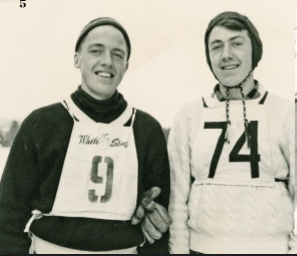
That—all except for the jug of cider, still prominent on campus—changed with a letter to the college paper in December 1909 from Fred Harris, who asked, “What is there to do at Dartmouth in the winter?” and answered: “We might take advantage of the splendid opportunities which the admirable situation of our college offers.” He proposed “that a ski and snowshoe club be formed.”
Thus, the Dartmouth Outing Club and its splendid offspring, the Dartmouth Winter Carnival, were born. Soon the alumni magazine would proclaim: “It begins to look as if the time might not be far distant when the Dartmouth man who can not ski and snowshoe and guide a toboggan down the steepest slopes will be ashamed to confess it.”
Dartmouth would never again be an indoor college, and its balladeers would sing, as the poet Richard Hovey did, of “the wolf-wind… wailing at the doorways.” Years later, the ski jumper Dave Bradley, the 1938 US champion in the Nordic combined who designed or renovated more than five dozen ski jumps, was on the US Nordic team at the 1960 Olympic Games in Squaw Valley, Calif., and was a 1985 inductee into National Ski and Snowboard Hall of Fame, wrote of the early Dartmouth ski area at Oak Hill: “There undergraduates and professors ski together (to the joy of themselves and the danger of others) and find their blood running redder for it!”
The Winter Carnival attracted women from Bryn Mawr, Vassar, Mount Holyoke, Smith, Wellesley and Skidmore, and it once prompted the Dartmouth Outing Club to issue this gentle advice to the Carnival’s female guests:
“We saw you last Carnival stand in the snow in pumps, silk stockings, and a fur coat… You did not look as happy as you tried to. So remember that there will be snow and that you will have to stand in it, and that it will be cold.”
Today’s women of Dartmouth—the college went coed in 1972—need no such warning. Two Dartmouth women have won Winter Olympic medals in skiing—Liz McIntyre (silver, 1994) along with Hannah Kearney’s gold in 2010. Counting the Paralympics, 30 Dartmouth women claim 25 Winter Games medals.
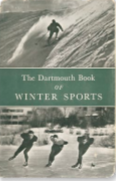
Here’s another stunning number: 36. Nora Stowell, on skis since she was 18-months-old, was the 36th member of her family to go to Dartmouth. A second-generation member of the ski team—she was captain in her senior year— she was drawn to Hanover by the pull of the hills. “People think I chose Dartmouth because my relatives came here,” she said in an interview for SKI in January 1995. “But I came for academics and the skiing…”
The winter tradition of which these Dartmouth women are the artful heirs was sculpted in an era of hickory ridge-top skis; poles with reinforced cedar cores, aluminum rings and leather webbing; and boots with a steel shank and double-stitched, wooden-pegged soles and heels. (Don’t forget the 12mm diameter hemp climbing ropes and the Swiss handmade ice axes, de rigeur for our sport of beguiling rigor.)
“It may happen that you fall into the snow,” the Dartmouth and US Olympic Team coach Walter Prager warned. “It might not be your fault, because skis can be very independent and perverse at the beginning.”
Over the years Dartmouth skiers courted more danger than merely falling in the snow. Ned Gillette, a member of the US cross-country ski team, climbed and skied down the 24,757-foot Mustagh Ata, at the time the highest ski expedition ever. He later skied across Ellesmere Island in the Canadian Arctic and skied around the bases of Mt. McKinley and Mt. Everest before being killed in Pakistan.
Today, most of us are slightly less daring, though we are known by our families for insisting on arriving at the ski lift sufficiently early to claim the first tracks, even when the conditions are so encrusted and slippy that even we, so devoted to our sport that it is regarded as a character flaw, have to acknowledge that there were no first tracks, just ice. No matter.
Many years ago a Dartmouth president, Ernest Martin Hopkins, recognized that the arranged marriage of the college and its winter traditions had a special beauty. “I would insist,” he said, “that the man who spends four years in our North Country and… who has not thrilled at the whiteness of the snow-clad countryside in winter… has not reached out for some of the most worthwhile educational values accessible to him at Dartmouth.”
So last winter, when one of my colleagues was braying and bragging about the gold medal in ice dancing won at Sochi by his fellow University of Michigan alums Meryl Davis and Charlie White, I shrugged in a disciplined nonchalance that barely concealed my contempt. Ice dancing? That’s no more a sport than a pork chop is a vegetable, and besides, we Dartmouths claimed a dozen Olympians, real athletes, most of them outfitted with ski poles and a few, women primarily, with guns, at Sochi. Yes, Michigan Stadium has a seating capacity of 109,901. Big deal. The Dartmouth Skiway has an uphill capacity of 3,300 skiers per hour. No question which one we prefer, especially when the wolf-wind is wailing at the doorways, and the snow drifts deep along the road.


